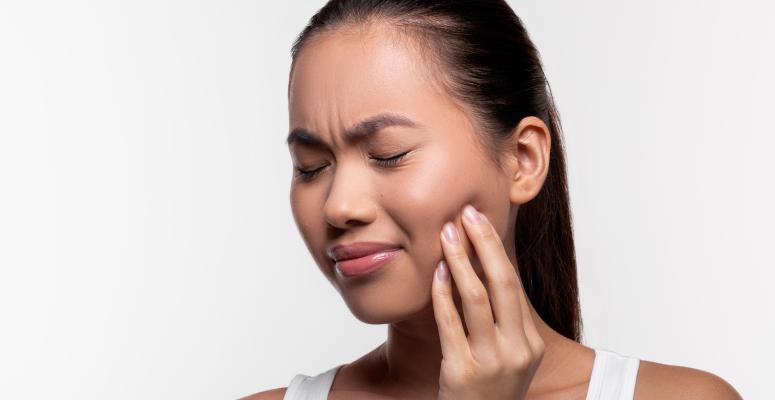
- What are some of the causes of TMJ dysfunction?
- What are some of the causes of TMJ headaches?
- What are some of the other symptoms of TMJ dysfunction that might indicate the need for physical therapy?
- What are some general treatment methods that could be used during PT to help someone who has TMJ headaches?
- How can physical therapy help a person address their TMJ headaches?
- Alliance PTP can help you find the right PT clinic to treat your headaches caused by TMJ dysfunction
Temporomandibular joint (TMJ) dysfunction is a type of joint condition that can make jaw movements very painful. It can make even little tasks difficult, like chewing food or opening your mouth. Fortunately, there are treatment options available to those who have TMJ dysfunction and experience more uncomfortable symptoms like headaches and jaw locking.
To learn about the causes of TMJ headaches and how physical therapy can help, keep reading.
What are some of the causes of TMJ dysfunction?
- The top and bottom jaw are not aligned correctly.
- The jaw is frequently clenching or the teeth are frequently grinding.
- The jaw has undergone traumatic injury.
- The teeth or jaw have become infected.
- The joints in the jaw are inflamed.
What are some of the causes of TMJ headaches?
For those with TMJ dysfunction, headaches are not uncommon. Here are some possible explanations for why this condition may cause someone to experience headaches:
- Excessive jaw activity — TMJ headaches can often be triggered by excessive jaw activity. Some examples of jaw activity include gum chewing, jaw clenching, teeth grinding, chewing and mouth opening. Excessive activity from your temporomandibular joint may be one of the reasons why you’re experiencing headaches or migraines.
- Muscle tension — Muscle tension in the jaw and neck may cause headaches or migraines. If the muscles in your jaw and neck are tense, moving your jaw may become difficult or even painful. Your TMJ headaches may be due to muscle tension.
What are some of the other symptoms of TMJ dysfunction that might indicate the need for physical therapy?
In some cases, the symptoms of TMJ dysfunction can be managed on one’s own. For others, the symptoms may become so bothersome that professional treatment is necessary. Physical therapy can treat patients with advanced TMJ dysfunction symptoms, like some of those listed below:
- Pain in the jaw — One of the other common symptoms that a person with TMJ dysfunction might experience is pain in the jaw. Moving the jaw may become difficult to perform without feeling pain.
- Clicking or popping noises — Another common symptom of TMJ dysfunction is hearing clicking or popping noises coming from the jaw when it is moved.
- Inability to fully open the jaw — Some people with this condition will report that they cannot fully open their jaw or that it becomes locked.
- Earaches — Another symptom that is associated with TMJ dysfunction is earaches.
- Dizziness — Some patients also report feeling dizzy as a result of their TMJ dysfunction.
What are some general treatment methods that could be used during PT to help someone who has TMJ headaches?
An excellent natural option for treating TMJ headaches is physical therapy. Physical therapists are professional experts in minimizing musculoskeletal pain and improving physical function. If you’re experiencing TMJ headaches that are bothering you or causing you significant discomfort, you’d likely benefit from consulting with a physical therapist.
- Soft tissue manipulation techniques — One way that physical therapy may be able to help someone who has TMJ headaches is by soft tissue manipulation. This technique involves manually manipulating the soft tissue in the affected area, such as the jaw. Soft tissue manipulation can reduce pain, improve mobility and reduce muscle tension.
- Jaw stretching exercises — Another method for reducing muscle tension is by stretching the muscles around the jaw. This may be performed through a series of jaw, face, neck, and shoulder exercises that help stretch and relax the muscle. Muscle tension is often associated with headaches, so jaw stretching exercises may benefit TMJ headaches.
How can physical therapy help a person address their TMJ headaches?
- Inflammation reduction — Physical therapy can also help alleviate inflammation in joints. If your TMJ headaches are caused by joint inflammation or swelling, PT may help.
- Muscle strengthening — Another benefit of PT for someone who experiences TMJ headaches is that PT can strengthen the muscles around the jaw. Muscle strengthening can help reduce built-up tension and better protect the joints.
- Circulation boost — PT is effective at improving circulation in the muscles, which may help reduce pain and inflammation in the jaw and head.
- Range-of-motion improvement — Those who experience TMJ headaches and limited range of motion in the jaw may improve their condition through PT.
- Pain reduction — PT can also help reduce pain in the jaw and head that may be associated with TMJ dysfunction.
Alliance PTP can help you find the right PT clinic to treat your headaches caused by TMJ dysfunction
At Alliance Physical Therapy Partners, we’re proudly bringing together physical therapy practices across the country to help people get the high-quality PT they need.
Want to see a physical therapist in person? We can put you in touch with an Alliance PTP partner that’s close to you and that can help you address your symptoms of TMJ dysfunction, including frequent headaches. The benefits of PT are plentiful. Don’t hesitate to schedule your first session.
Not keen on in-person PT sessions or not close to an Alliance PTP partner? No worries. We also offer effective and affordable virtual physical therapy through our Agile Virtual Physical Therapy platform.
Come find help for your injury or chronic condition today!
Get Help at a Location Near You
